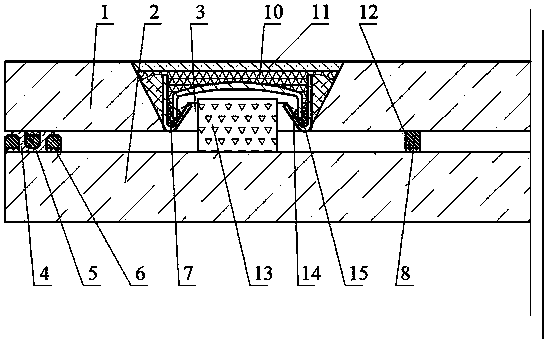Planar tempered vacuum glass edge-sealed by using sealing strips and with getter, and preparation method thereof
A technology of vacuum glass and sealing strip, applied in glass manufacturing equipment, glass production, glass forming and other directions, can solve the problems of small space, affecting the appearance, complicated getter encapsulation and placement process, etc.
- Summary
- Abstract
- Description
- Claims
- Application Information
AI Technical Summary
Problems solved by technology
Method used
Image
Examples
Embodiment 1
[0070] Embodiment 1: see figure 1The vacuum glass consists of upper glass 1 and lower glass 2. The two pieces of glass are tempered glass or half-tempered glass, one of which is low-emissivity glass. The production method is as follows: First, cut the required size according to the shape and size of the vacuum glass to be produced. A piece of flat glass and a piece of low-emissivity glass, remove the film at the welding part of the low-emissivity glass, drill a through hole at the corner of the upper glass 1 as the air outlet 3, and perform edge grinding, chamfering, cleaning and drying on the upper and lower glass , use screen printing technology to print the sealing strip on the peripheral welding of the upper and lower glasses and print the support 8 on one of the glasses at the same time; secondly, send the two pieces of glass into the tempering furnace for air-cooled tempering to obtain tempered or semi-tempered Glass; at the same time prepare high polymer 12, high polyme...
Embodiment 2
[0071] Example 2: see figure 2 , the vacuum glass is made up of upper glass 1, middle glass 9 and lower glass 2. Among the three pieces of glass, at least the upper and lower glasses are tempered glass or semi-tempered glass, and at least one piece of glass is still low-emissivity glass. The manufacturing method is as follows: first According to the shape and size of the vacuum glass to be produced, cut three pieces of flat glass of the required size, drill a through hole on the upper glass 1 and the middle glass 9 respectively to form the air suction port 3, wherein the through hole on the upper glass 1 is larger than the middle glass 9, and perform edge grinding, chamfering, cleaning, and drying on the three pieces of glass; secondly, use tempered glass ink to print the sealing strip 5 and 6. Print the support 8 on the lower surface of the upper glass 1 and the upper surface of the lower glass 2, send the middle glass 9 into a high-temperature furnace for high-temperature t...
PUM
 Login to View More
Login to View More Abstract
Description
Claims
Application Information
 Login to View More
Login to View More - R&D
- Intellectual Property
- Life Sciences
- Materials
- Tech Scout
- Unparalleled Data Quality
- Higher Quality Content
- 60% Fewer Hallucinations
Browse by: Latest US Patents, China's latest patents, Technical Efficacy Thesaurus, Application Domain, Technology Topic, Popular Technical Reports.
© 2025 PatSnap. All rights reserved.Legal|Privacy policy|Modern Slavery Act Transparency Statement|Sitemap|About US| Contact US: help@patsnap.com


